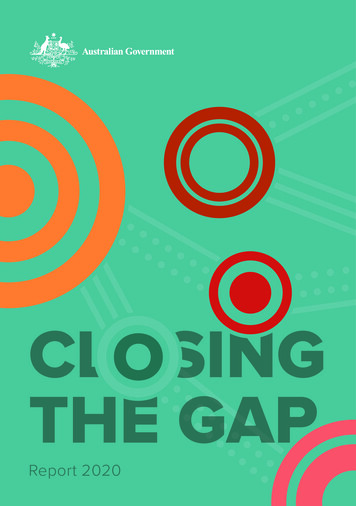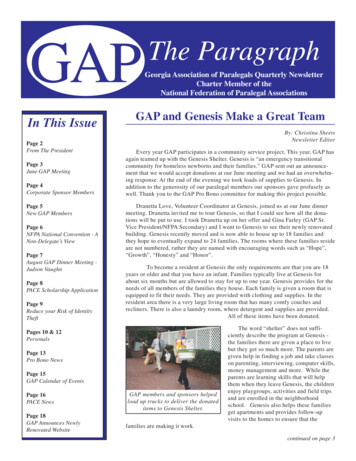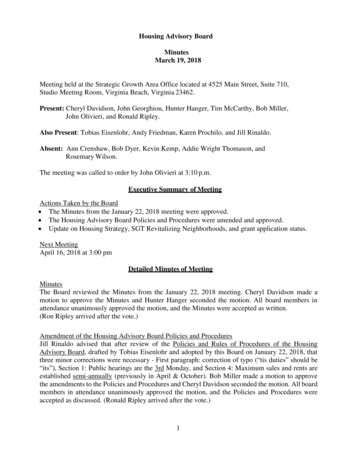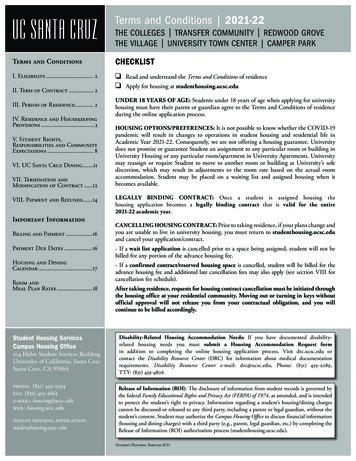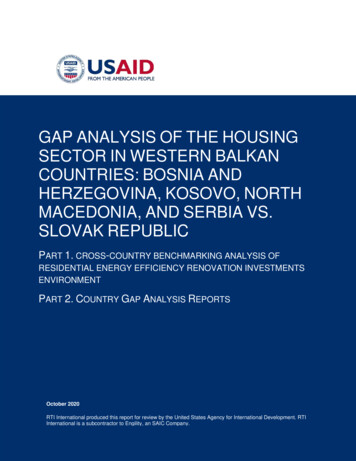
Transcription
GAP ANALYSIS OF THE HOUSINGSECTOR IN WESTERN BALKANCOUNTRIES: BOSNIA ANDHERZEGOVINA, KOSOVO, NORTHMACEDONIA, AND SERBIA VS.SLOVAK REPUBLICPART 1. CROSS-COUNTRY BENCHMARKING ANALYSIS OFRESIDENTIAL ENERGY EFFICIENCY RENOVATION INVESTMENTSENVIRONMENTPART 2. COUNTRY GAP ANALYSIS REPORTSOctober 2020RTI International produced this report for review by the United States Agency for International Development. RTIInternational is a subcontractor to Engility, an SAIC Company.GAP ANALYSIS: BOSNIA AND HERZEGOVINA, KOSOVO, NORTH MACEDONIA, AND SERBIA V. SLOVAK REPUBLIC OCT 2020PAGE 1
GAP ANALYSIS OF THE HOUSINGSECTOR IN WESTERN BALKANCOUNTRIES: BOSNIA ANDHERZEGOVINA, KOSOVO,NORTH MACEDONIA, ANDSERBIA VS. SLOVAK REPUBLICPREPARED BY: BESIM NEBIU, ELENA MILANOVSKA, MIRZETRIBIC, ASTGHINE PASOYANContributing Authors: Elena Szolgayová, Zoran Kostov, Liljana AlcevaDragan Blazev, Jasmin Gabela, Besim Islami, Zija Kamberi, BranislavaLepotic KovacevicOctober 2020DISCLAIMERThe author’s views expressed in this publication do not necessarily reflect the views of theUnited States Agency for International Development or the U.S. Government. This document isintended to comply with Section 508 Standard of the Federal Acquisition Regulation. If you haveany difficulties accessing this document, please contact accessibliity@rti.org.GAP ANALYSIS: BOSNIA AND HERZEGOVINA, KOSOVO, NORTH MACEDONIA, AND SERBIA V. SLOVAK REPUBLIC OCT 2020 PAGE2
TABLE OF CONTENTSIntroduction1Executive Summary3Housing Perspective3Energy Efficiency Perspective5Banking and Finance Perspective7Part 1. Cross-Country Benchmarking Analysis of Residential Energy Efficiency Renovation Investments Environment10Housing Perspective10Energy Efficiency Perspective16Banking: Risk and Risk Perception23Part 2. Country Gap Analysis Reports38Slovak RepublicBosnia and Herzegovina3857Housing Sector Analysis57Energy Sector Analysis69Banking Sector Analysis78Kosovo84Housing Sector Analysis84Energy Sector Analysis91Banking Sector Analysis98North Macedonia105Housing Sector Analysis105Energy Sector Analysis114Banking Sector Analysis120Serbia126Housing Sector Analysis126Energy Efficiency Analysis140Banking Sector Analysis147GAP ANALYSIS: BOSNIA AND HERZEGOVINA, KOSOVO, NORTH MACEDONIA, AND SERBIA VS. SLOVAK REPUBLIC OCT 2020PAGE 3
LIST OF FIGURESFigure 1. Electricity and Natural Gas Prices in Sample Countries vs. EU (2019)16Figure 2. Progress in Transposition of EU Energy Efficiency Legislation for Buildings (EED and EPBD)17Figure 3. Number of Renewed Dwellings with Direct State Support48Figure 4. Loans and Subsidies Provided from Public Funds49Figure 5. Budget of the State Housing Development Fund (in EUR)49Figure 6. State Budget Allocations for Housing52Figure 7. Building Saving – Provided Loans53Figure 8. Mortgage Loans53Figure 9. Management of an HOA86LIST OF TABLESTable 1. Summary of Housing and HOA Legislation10Table 2. Secondary and Associated Legislation Affecting MABs/HOAs11Table 3. Key Decision-making Rules on Housing Management and Identified Gaps12Table 4. Key Financing Tools Supporting MAB/HOA Investments in the Selected WB Countries14Table 5. Status of Transposition of EPBD and EED into Primary Legislation and Policy Planning19Table 6. Energy Auditing and Building Energy Certification20Table 7. Institutional Capacities for Promotion of EE Investments in Buildings21Table 8. Potential for Application of ESCOs and EPC in MABs22Table 9. Comparative Analysis of Risks and Risk Perceptions24Table 10. Comparative Analysis of Provisioning Requirements and Banking Regulations26Table 11. Availability and Possibility to Set Up Guarantee Instruments29Table 12. Commercial Banking Products Available to HOAs31Table 13. Development Banks’ Credit Lines Available to HOAs33Table 14. Housing Refurbishment in Slovakia47Table 15. Overview of the Outcomes within the Initiative JESSICA55Table 16. Division of Targets per Sector and per Article of the EED71Table 17. Kosovar Total Residential Building Stock92Table 18. Kosovo EE Targets and Indicative Levels and Their Realization (ktoe)95Table 19. Intermediate Targets for Energy Savings for 202095Table 20. Total Residential Stock99Table 21. Estimates of Building Stock and Investment Potential137Table 22. Division of Targets per Sector and per Different Article of EE Directive (example)142GAP ANALYSIS: BOSNIA AND HERZEGOVINA, KOSOVO, NORTH MACEDONIA, AND SERBIA VS. SLOVAK REPUBLIC OCT 2020PAGE 4
AbbreviationsALDRENAlliance for Deep Renovation in BuildingsASHRAEAmerican Society of Heating, Refrigeration, and Air-ConditioningEngineersASHVEAmerican Society of Heating and Ventilation EngineersBFEEBudgetary Fund for Energy EfficiencyBiHBosnia and HerzegovinaBRSBuilding Renovation StrategyBoQBill of QuantitiesCGBcentral government buildingsCRMCredit Risk ManagementEEEnergy EfficiencyEIBEuropean Investment BankEBRDEuropean Bank of Reconstruction and DevelopmentEEDEnergy Efficiency DirectiveEIBEuropean Investment BankEPBDEnergy Performance in Buildings DirectiveEPCEnergy Performance ContractingESCOEnergy Service CompanyEUEuropean UnionEVCSEuropean Voluntary Certification SchemeFECfinal energy consumptionFBiHFederation of Bosnia and HerzegovinaGIZGerman Society for International Cooperation(Deutsche Gesellschaft für Internationale Zusammenarbeit)GGFGreen for Growth FundGSMGlobal System for Mobile CommunicationHFHIHabitat for Humanity InternationalHOhomeownerHOAHomeowners AssociationHVA&CRHeating, Ventilation, Air-Conditioning, and RefrigerationISOIndependent System OperatorGAP ANALYSIS: BOSNIA AND HERZEGOVINA, KOSOVO, NORTH MACEDONIA, AND SERBIA VS. SLOVAK REPUBLIC OCT 2020PAGE 5
KCGFKosovo Credit Guarantee FundKfWKreditanstalt für Wiederaufbauktoekilotonnes of oil equivalentkWhkilowatt hourLEUELaw on Efficient Use of EnergyLOEELaw on Energy EfficiencyLMCLicensed management companiesMABmulti-apartment buildingsMCCMillennium Challenge CorporationMOMEMinistry of Mining and EnergyMMBManagement and Maintenance companyMSMEmicro, small, and medium enterpriseNBFNational Budgetary FundNEEAPNational Energy Efficiency Action PlanNECPNational Energy and Climate PlansNZEBnon-zero energy buildingPIMOPublic Infrastructure Management OfficeRBMResidential building managementREELIHResidential Energy Efficiency for Low-Income HouseholdsREEPRegional Energy Efficiency ProgramRESRenewable Energy SourceRSRepublic of SrpskaSDCSwiss Agency for Development and CooperationSEEKSubsidies for Energy Efficiency in KosovoSFRBState Fund for Housing DevelopmentSHDFSlovakia Housing Development FundsSMEsmall and medium enterpriseUNDPUnited Nations Development ProgrammeUSUnited StatesUSAIDUS Agency for International DevelopmentWBWestern BalkansGAP ANALYSIS: BOSNIA AND HERZEGOVINA, KOSOVO, NORTH MACEDONIA, AND SERBIA VS. SLOVAK REPUBLIC OCT 2020PAGE 6
INTRODUCTIONThe residential building sector is one of the largest energy end-users in all Western Balkan(WB) countries, consuming 30 percent to 60 percent of all final national energy consumption. 1Such high energy demand and low energy performance is caused by several factors, includingaging building stock, decades of poor maintenance, legal-regulatory barriers, a lack of clearownership structure and responsibilities, and poor management of residential buildings.The landscape for financing energy efficiency (EE) varies considerably across different sectors.The private sector (individuals, households, and businesses) appears to have well-functioningmarkets, where consumers can easily borrow funds for EE and other investments. The publicsector is almost completely dependent on subsidized financing and grants, even though EEinvestments have the potential to generate savings and allow the repayment of investments ifproperly structured. In most WB countries, the national governments engage in sovereign loansfrom international financial institutions, which are later invested in educational, medical, and otherpublic institutions’ buildings, while the loans are repaid from the state budget. Examples includethe Public Investment Management Office (PIMO) or the World Bank and KfW (Kreditanstalt fürWiederaufbau) loans for public building renovation in the Republic of Serbia (called Serbiahereafter).Multi-apartment buildings (MABs), however, remain an untapped market for commercial lendingfor EE investments despite the sector’s significant share in national energy consumption. Thedelay in MAB EE market maturity is a complex problem with multiple variables involved,including: Legal-regulatory barriers for securing investments in MABs, especially dealing withregistration and liabilities related to common property, enforcement of MABmaintenance fees, legally securing financial liabilities acquired by homeowners’associations (HOAs), and collective decision-making;Poor institutional capacities of HOAs for managing and maintaining, designing, andimplementing complex investment projects, adequately procuring professional services;Limited cashflow generated by HOAs due to poor collections and persisting socialvulnerability in the population;Bankers’ perceptions of high risks in the HOA sector and legal limitations to unsecuredlending, while HOAs do not possess any assets subject for collateralization;Long payback periods of investments in aging MABs with a multitude of outstandingrepair- and maintenance-related issues, in addition to EE, such as structural, aesthetic,or functionality improvements;Low awareness of potential financial and comfort gains from EE investments amongbuilding occupants; andA lack of technical assistance and external credit-guarantee vehicles to facilitateinvestments in MAB EE.Country-based technical studies in the WB countries provide estimates that show a significantpotential for reducing energy consumption and greenhouse gas (GHG) emissions in MABresidential buildings by 30–40 percent. Such measures can lead to significant monetary1IEA statistics, 2015.GAP ANALYSIS: BOSNIA AND HERZEGOVINA, KOSOVO, NORTH MACEDONIA, AND SERBIA VS. SLOVAK REPUBLIC OCT 2020PAGE 1
savings, improved environmental indicators, as well as reduced energy-import dependence.Meanwhile, the poor financial standing of HOAs makes it difficult for the banks to provide loansto HOAs with acceptable risks. Hence, HOAs do not have an obligation or an incentive to investin EE measures.Amendments to the Housing Codes and other related legislation, while building the capacities ofHOAs, are essential to preparing large portions of the urban housing stock for commercialfinancing. The establishment of effective housing legislation through the adoption of bestpractices from neighboring countries with successful track records in implementing similarreforms would bring about a fundamental shift in WB countries. Legislative action represents thefirst step toward facilitating energy-efficient refurbishment, opening the MAB residential sectorfor commercial financing, and expanding the facilities-management market. Subsequent stepswill require capacity-building support for local institutions to strengthen the managementcapabilities of HOAs and building the confidence of commercial banks to lend to HOAs withfinancing products that are specifically designed for the needs of HOAs and the economics ofEE investments. In the Slovak Republic (called Slovakia hereafter), legal reform, capacitybuilding support, and tailor-made financing have led to the mobilization of HOAs andengagement of commercial banks in the delivery of financing solutions and the renovation of themajority of MAB housing. The reforms in Slovakia that were initially heavily supported withsubsidized financing and institutional support gradually evolved to a fully commercial, selfdriven, and market-based framework. In this market-based framework, nearly every local bankoffers an HOA loan product, and every HOA can invest in renovations and repay from its ownfees and savings.All four countries targeted in this assignment―Bosnia and Herzegovina (BiH), Kosovo, NorthMacedonia, and Serbia―were part of former Yugoslavia and share common characteristics.The four countries have taken similar transition paths as ex-Yugoslav republics afterindependence. Management and maintenance of MABs is a huge challenge for all fourcountries. Although apartments have been privatized since the 1990s, a sustainable system forfinancing the maintenance of common areas in the buildings has yet to be established. Most ofthe new homeowners are not ready to take on responsibilities for the maintenance of commonareas in the buildings and the refurbishment of MABs. Commercial financing through banks andother financial institutions is scarce, leading to further deterioration of buildings that alreadyhave very poor energy performance because of the inadequate building standards used whenthey were constructed in the 1960s–1980s. Financial resources from the budgets ofmunicipalities and state agencies are insufficient and are mostly used to support maintenanceand emergency interventions.The aim of the gap analysis is two-fold:1. Review the housing policies, institutional structures, EE policies, reform agendas, as well asthe banking-sector landscape in the selected four WB countries, and provide comparativegap analysis with the benchmarked best practices from the regions that have madesubstantial progress in MAB refurbishing (e.g., Slovakia); and2. Identify opportunities for legislative and regulatory improvements, capacity-building support,and flexible financing in each WB country that are necessary for the improvement of housingoperation and maintenance and for developing and enabling the environment for EEinvestment lending to HOAs.GAP ANALYSIS: BOSNIA AND HERZEGOVINA, KOSOVO, NORTH MACEDONIA, AND SERBIA VS. SLOVAK REPUBLIC OCT 2020PAGE 2
In addition to the present cross-country benchmarking analysis, the study produced individualcountry reports that will provide interested readers with more details on national-level policiesand the institutional and market development contexts.EXECUTIVE SUMMARYThe thermal renovation of housing requires significant financial resources. The market failed todeliver these resources due to barriers rooted in national housing, EE policies, and bankingrules and practices. The lack of meaningful investment in the sector for the modernization ofMABs has its roots in each country’s complex institutional landscape, gaps in knowledge, andcapacities of various players in the market, and the generally low level of awareness andmaturity of all engaged partners in the four reviewed countries including BiH, Kosovo, NorthMacedonia, and Serbia. This study analyzes these countries’ policies and institutional, financial,and information barriers in housing, banking, and EE and contrasts them with those of theoutstanding forerunner in these fields, Slovakia.HOUSING PERSPECTIVELegal/Regulatory GapsThe WB countries have initiated housing policy reforms since 2009. All four countries passedlaws that regulate the maintenance and management of MABs in their legal systems in the pastdecade. Despite adopted legislation, the past decade has not seen sufficient growth of properinstitutional capacities or developed the necessary processes for ensuring the adequateenforcement of adopted policies. Furthermore, these laws still have shortcomings, arefrequently modified, and are thus unstable. In contrast, the Slovak legal framework has beenfunctioning for three decades (since 1993) with only a few amendments. All focus countriesexcept North Macedonia have a separate condominium law. With the exception of theFederation of Bosnia and Herzegovina (FBiH), they allow for registered HOAs to act as bothlegal entities and management entities for MABs.Gap: Unlike the Slovak system―in which HOAs are largely self-regulated and the residentialbuilding maintenance and management sector functions have low state interference, control,and oversight over the work of HOAs and licensed management companies (LMCs)―in all fourcountries, the policymakers intended to create frameworks that implement robust institutionalarchitecture. This institutional architecture allows state regulation of the sector, includingcontrol and oversight over the work of HOAs and management companies. Thisarchitecture consists of various regulatory bodies and/or inspectorates. Analysis showsthat these regulatory structures are too complex and have limited functional effectiveness. Overthe past decade, they have not produced visible effects in improving the quality of management,maintenance, and modernization of MABs.Recommendation: The current systems of oversight and control need to be simplifiedor abolished because they are not fulfilling their functions.Gap: Analysis of the adopted secondary legal framework shows that national governmentshave adopted the most critical policies, bylaws, and guidebooks regulating MAB operations andmanagement. However, there are many gaps and inconsistencies among the laws, with manyexisting provisions lacking enforcement.GAP ANALYSIS: BOSNIA AND HERZEGOVINA, KOSOVO, NORTH MACEDONIA, AND SERBIA VS. SLOVAK REPUBLIC OCT 2020PAGE 3
Recommendation: Following the experience of Slovakia, countries need acomprehensive and systematic analysis of the impacts of other laws on HOA laws toidentify and address gaps and loopholes in implementation. This will be an importantstep in making these systems functional; it will help eliminate inconsistencies,duplication, and barriers to implementation and reduce the liabilities and obligations thatthe law imposes. The gaps and inconsistencies need to be properly addressed,preferably by amending the existing laws, as the introduction of new laws wouldexacerbate the predictability and stability of the legal framework.Two key contributing factors in the effectiveness of the Slovak HOA regulations are (1) ease ofdecision-making of homeowners (50 percent 1 vote) instead of 2/3 often demanded in WBcountries and (2) simple and effective rules for the collection of MAB fees, enforced throughlegal lien and simplified court and collection procedures. All four WB countries are advancing tosome extent toward integrating such effective regulations but are not yet fully able to apply andenforce of these factors.A significant portion of the MAB stock in WB countries is already managed either by HOAs orLMCs: 64 percent in North Macedonia, 40 percent in Serbia, and most buildings in Slovakia.With the exception of Kosovo, these countries all have a substantial number of HOAs; andFBiH, North Macedonia, and Serbia all have sizeable LMC markets.Gap: The quality of maintenance service is still low in the four countries due to failure in theproper collection of fees and dues. Combined issues of legal gaps, cumbersome decisionmaking, limited cashflow, and insufficient payment enforcement have led to persisting deficits ininvestment funds and funds for general maintenance.Recommendation: In addition to addressing the above gaps in the laws andaccelerating their proper enforcement, HOAs need to take immediate steps and supportmechanisms for the generation of proper financial resources for building repair andmaintenance. HOAs must ensure internal and external financing through facilitatingcollection of maintenance fees for routine maintenance, generation of reserve funds forcapital renovation, and access to debt through (1) accumulating “reserve funds,” whichcan be committed as down payments on a loan; (2) giving the HOA the power of lien,which the HOA can use to impose the payments through collection agencies that auctionnonpayers’ apartments; and (3) using credit guarantees linked to HOA cashflow, etc.Housing Policy GapsThe renovation boom in Slovakia from 2000–2010 resulted from the combination of a solid legalframework, institutional support, and availability of financing options and tools for the renovationof MABs. By 2016, 47.5 percent of the stock had been refurbished. While built on a generallybetter-performing economy and higher-than-average welfare of the population, the Slovaksuccess story is largely anchored on simple and achievable regulations, combined withaffordable policy and market tools that were developed throughout the 1990s and 2000s. Thesefactors gradually made MAB renovation projects technically easier to do and financiallyaffordable for the HOAs.Gap: The four countries lack legal simplicity and policy stability, and most of the policyinstruments that are available to Slovak MABs are absent in the WB countries. Under the actinglegal framework, both HOAs and residential building management (RBM) companies in the WBcountries can apply for a loan but only on behalf of all the owners (without HOA membersGAP ANALYSIS: BOSNIA AND HERZEGOVINA, KOSOVO, NORTH MACEDONIA, AND SERBIA VS. SLOVAK REPUBLIC OCT 2020PAGE 4
individually signing agreements). Despite legal provisions, the market does not offer commercialloans for HOAs. The banks may be willing to lend to HOAs only with loan securities providedthrough collateralization (i.e., pledging an asset). Very few MABs can meet such a requirementbecause the HOAs do not possess assets other than the building common spaces, which do notrepresent a disaggregated asset that can be collateralized. An HOA’s common assets areusually inseparable parts of its building’s public spaces (e.g., stairwells, courtyards, andentrances), are not registered as a separate asset (roofs, attics), and often represent no liquidvalue to banks (has no separate property certificate, cannot be sold/rented as a stand-aloneasset).Recommendation: In Slovakia, the Obligatory (Reserve) Fund for maintenance andrepair is usually used as collateral for a loan. Today, Slovak banks are comfortableproviding loans to HOAs and only use these funds to collateralize/secure repayments ofmodernization loans. This scenario evolved as a result of several years of the HOAsdeveloping regular payments of fees at higher volumes; in the interim, other forms ofguarantees (such as state guarantee programs) were used until there was interest andconfidence among banks to work with HOAs. WB countries should implement a similarmechanism with a similar trajectory of milestones to promote large-scale buildingrenovations.ENERGY EFFICIENCY PERSPECTIVEThis analysis conducts a stocktaking of the energy efficiency policies and programs in BiH,Kosovo, North Macedonia, and Serbia, comparing against the benchmark of the Slovak caseand the Transposition Roadmap of Energy Community acquis communautaire (i.e., thecollective legislation) for Contracting Parties. The analysis addresses EE policy, building energyperformance, legal/regulatory domain, active institutional capacities, energy auditing, buildingenergy certification, energy performance contracting, ESCOs and market readiness. Theanalysis revealed the following gaps and barriers to large-scale market uptake of EEinvestments in the MAB residential-building sector.Legal/Regulatory GapsWhile the legal/regulatory landscape, policies, and plans continue to be a priority for thesecountries’ governments, many gaps remain for providing a favorable policy environment for EEinvestments in residential buildings. The Energy Community and donors/international financialinstitutions (IFIs) have strongly supported these four countries in their efforts to set up a guidingpolicy framework and transpose the European Union (EU) Energy Efficiency Directive (EED)and the Energy Performance in Buildings Directive (EPBD) into national legislation. Despite allsupport and policy priorities, these efforts had mixed success in developing, adopting, andimplementing favorable policy frameworks for building EE. Specifically, for the policy domain,the national governments and donor agencies must provide technical assistance to acceleratethe enforcement and implementation of legal/regulatory reforms and progress monitoring,including the recommendations below.Gap: Energy prices lack incentives for the promotion and implementation of EE investment inbuildings, especially residential ones.Recommendation: Transition social-assistance and energy subsidies toward improvedutility affordability through enhanced EE. Such a transition will create a more sustainableGAP ANALYSIS: BOSNIA AND HERZEGOVINA, KOSOVO, NORTH MACEDONIA, AND SERBIA VS. SLOVAK REPUBLIC OCT 2020PAGE 5
and long-term remedy to affordability problems while creating incentives for EEinvestments and monetization of buildings, resulting in substantial energy savings andthe reduction of emissions.Gap: Laws on Energy Efficiency in Buildings were adopted very recently in all countries, butlack enforcement.Recommendation: Maintain the momentum for the transposition of EED and EPBD andsupport implementation with continued development and the enforcement of adequatesecondary legislation related to the EE of buildings.Gap: Delayed development and adoption of the regular National Energy Efficiency ActionPlans (NEEAPs).Recommendation: Reemphasize the residential buildings sector in the NEEAPs,providing for discrete administrative delivery models and tailor-made financinginstruments based on cost-effective EE improvement targets. Accelerate the adoption ofthe next NEEAP in BiH. Update the NEEAP and tracking implementation progress in thefourth NEEAP.Gap: Delays in adopting a Building Renovation Strategy (BRS).Recommendation: Accelerate the development and adoption of BRSs in harmony withNEEAPs and in compliance with EPBD requirements, allowing for a knowledge-based,technically and financially prioritized course of tactical action in building renovation, withthe worst-performing buildings targeted first. BRS must quantify the benefits of suchbuilding renovation not only in monetary and energy savings but also enhanced buildinglifespans, improved security and resilience, improved indoor environments, reducedsocial tensions, mitigated dependence on imports, added climate change mitigationeffects, etc.Gap: A lack of or poor enforcement of mandatory building energy performance certification.Recommendation: Build the capacities of national authorities (particularly in BiH) andtechnical experts to accelerate enforcement in energy-performance certification,providing grant resources and technical assistance for popularizing these certificatesamong public and real-estate players. Ensure that they are transparent, credible, andmethodologically uniform for all certified buildings.Gap: A lack of proper monitoring and verification of housing-sector needs, implementation ofresidential EE investments, comfort improvements, genuine affordability issues, subsidy needs,and limited information for decision making on the effectiveness of investments, improved utilityaffordability, phase-out of subsidies, etc.Recommendation: Require the application of internationally recognized monitoring andverification protocols in pilot projects, programs, and credit lines with a centralizednational reference database to inform further decisions on phasing out subsidies,carefully calibrating concessionality of financing (interest rates, the share of grant cofinancing, grace periods, etc.), or planning scale-up. This must include reporting onenvironmental, social, resilience benefits, and macroeconomic and national energysecurity gains.GAP ANALYSIS: BOSNIA AND HERZEGOVINA, KOSOVO, NORTH MACEDONIA, AND SERBIA VS. SLOVAK REPUBLIC OCT 2020PAGE 6
Gap: A lack of formal regulation and enforcement of energy auditing and accreditation ofenergy auditors.Recommendation: Ensure that energy auditing provisions are in accordance with theEuropean norms/independent system operators (ISOs) to provide comparable andconsistent quality and content of energy-auditing reports, creating a reliable source forassessing the technical and economic potential for EE investments.The four target countries should set the above regulatory provisions as milestones to beachieved in the cooperation program between the national governments and donors/IFIs. Thebuilding renovation niche requires a solid fact-based policy roadmap that is comprehensivelystipulated by EED and EPBD transposition requirements.Furthermore, as the basic provisions are put in place for EE in buildings, national policies needto integrate the buildings’ sector into the broader low-carbon development agenda, including: development and adoption of the National Energy and Climate Plans (NECPs), anddevelopment and adoption of the National Net Zero Energy Building (NZEB) Strategyand Roadmap.Institutional and Financial Capacity GapsGap: Limited institutional resources of ministries, lack of energy agencies, and the absenceor poor capacity/scope of EE funds.Recommendation: Given the limited staffing of ministries, governments and donorsmust seek to enhance the capacities of energy or housing agencies and EE funds toproperly develop EE and renovation project portfolios for buildings. These efforts shouldinclude enhancing the capacities of public institutions related to international bestpractices in legislation, technical assessments, business planning, financing, contracting,management, commissioning, and monitoring and verification of building renovation,among others. The efforts of government agencies, funds, donors, and IFIs must bebetter coordinated and combined through pooled financing, coordination committees,and the leveraging of mutual efforts. These efforts should ensure the development of anenergy auditors’ cadre and should provide training, accreditation, and certification forauditors.Gap: Limited engagement of energy-service companies (ESCOs) and energy performancecontracting (EPC).Recommendation: Financiers (banks and funding entities for EE projects) must seek tocustomize financing terms to make them applicable to ESCOs/EPCs, including projectfinance, factoring, risk-securing activities based on savings cashflows, and tripartite (i.e.,three-party) contracting, under which ESCOs could borrow financing backed by HOAsand/or household fin
Figure 5. Budget of the State Housing Development Fund (in EUR) 49 Figure 6. State Budget Allocations for Housing 52 Figure 7. Building Saving - Provided Loans 53 Figure 8. Mortgage Loans 53 Figure 9. Management of an HOA 86. LIST OF TABLES . Table 1. Summary of Housing and HOA Legislation 10 Table 2.




